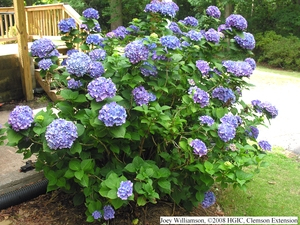photo by Joey Williamson, Clemson Extension
The hydrangea in front of my house is just a bunch of bare sticks in the winter, screaming to be cut down. It looks like quite a leafless eyesore after losing foliage in the fall. During the winter the local chickadees use it as a perch beneath the hanging bird feeder. The avian flocks do not mind its ugliness. I don’t mind it either knowing the flower buds are on those naked sticks, waiting for the coming spring and summer to bloom. There are five different types of hydrangeas. Some bloom on old wood and some on new wood.
My hydrangea is a Hydrangea macrophylla or Bigleaf Hydrangea. The ones that bloom on old wood carry the next year’s flower buds on the barren sticks, through the fall, winter and next spring. If these are pruned during the fall, winter or spring, the flower buds will be removed. The plant will grow new stems and leaves from the base of the plants, but these stalks will NOT contain flower buds, therefore no flowers that year. The flower buds are produced and set after the plant flowers in June and July but before fall. Any pruning should be done as the flowers fade during the summer to avoid cutting off the buds. I remember to prune Hydrangea macrophylla when I cut flowers for a vase to bring inside. Sometimes our winters are just too cold for the tender over-wintering buds, killing the buds, resulting in no flowers the following summer even if pruned correctly.
Hydrangea macrophyllas are divided into two groups, Hortesia and Lacecap. Hortensias have big ball flower forms. Lacecaps have a somewhat flat top shaped flower. These bloom on old wood, prune after flowering but before August 1st.
Hydrangea quercifolia, commonly called Oakleaf Hydrangea also blooms on old wood. Prune after flowering. If terminal buds are killed during winter, no flowers will be produce. Should be protected in zone 5.
Two other common hydrangea bloom on new wood, wood produce from the plant during the same year. These are Hydrangea paniculata grandiflora, commonly called Panicle or PG Hydrangea and Hydrangea arborescens, commonly called Smooth Hydrangea. These can be pruned in late fall, winter or early spring. The flower buds will be produced on the new wood produced in spring.
Hydrangea paniculata, Panicle Hydrangea. Prune in early spring.
Hydrangea arborescens, Smooth Hydrangea blooms on new wood. Prune in winter or early spring.
